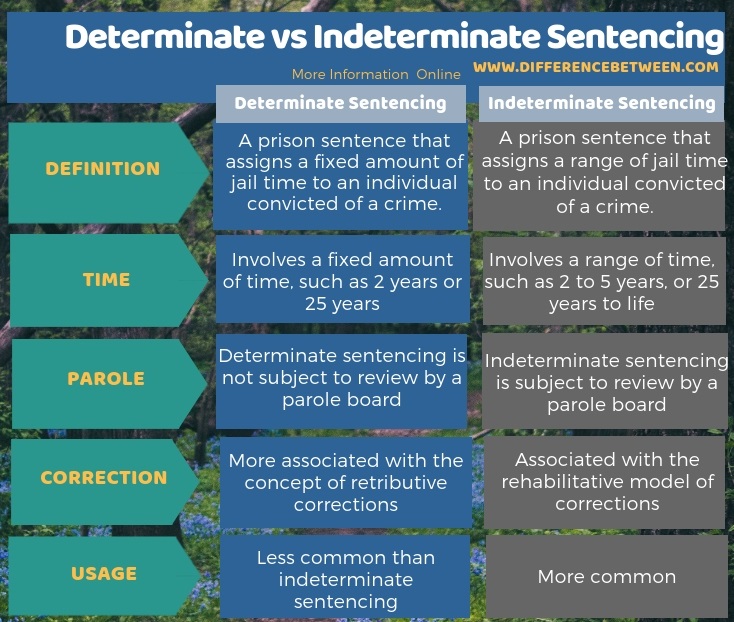Difference Between Determinate and Indeterminate Sentencing
Table of Contents
The key difference between determinate and indeterminate sentencing is that the determinate sentencing is a prison sentence that is definite and is not subject to review by a parole board whereas the indeterminate sentencing is a prison sentence that consists of a range of years, not a fixed amount of time.
Determinate and indeterminate sentencing are two types of criminal sentencing Determinate sentencing involves a fixed amount of prison time whereas indeterminate sentencing involves a range of time such as two to five years.
CONTENTS
1. Overview and Key Difference
2. What is Determinate Sentencing
3. What is Indeterminate Sentencing
4. Side by Side Comparison – Determinate vs Indeterminate Sentencing in Tabular Form
5. Summary
What is Determinate Sentencing?
Determinate sentencing refers to a prison sentence for a fixed amount of time, rather than a range of time. For example, determinate sentencing will involve an offender being sentenced to one year in prison, rather than up to one year. Which means, the offender has to spend that whole year in prison. In other words, he is not eligible for parole.
Determinate sentencing is not as common as indeterminate sentencing. Moreover, determinate sentencing is often seen as a tougher system because of its mandatory prison time.

Furthermore, determinate sentencing includes sentencing guidelines, mandatory minimum sentences, and enhanced sentences for certain crimes. The sentencing guidelines help a judge to consider the individual circumstances of cases while determining a sentence. However, in the case of mandatory minimum and enhanced sentences, the judge has no or little authority in setting the terms of a sentence. For example, a sentence for a case of sexual battery may be an automatic prison term for three years.
What is Indeterminate Sentencing?
Indeterminate sentencing refers to a prison sentence that assigns a range of years, rather than a fixed amount of time. For example, indeterminate sentencing can include a sentence of five to ten years or twenty-five years to life. This type of sentencing determines only the minimum and the maximum amount of years the offender has to remain in prison. Once the offender has spent the minimum amount of years in prison, he is subject to review by a parole board. For example, if the prisoner’s sentence is for two to five years, he can appear before the parole board once he has remained two years in prison.

Parole means temporarily releasing the prisoner before the complement of his full prison sentence. However, if the offender commits any act to violate the parole, for example, commit another crime, or use drugs, he or she will be returned to prison.
Also, note that not all prisoners who get indeterminate sentencing get parole. Because, the parole board considers certain factors before granting parole to inmates who have received indeterminate sentences.
Some Factors Considered During Parole
- Original recommendation by the judge on the case
- The inmate’s criminal history
- Length of the time the inmate has served in prison to date
- Inmate’s behaviour in prison
- Inmate’s participation in rehabilitation programs and other resources available to him or her
- Concerns about the inmate’s potential release insofar as the public’s safety
What is the Difference Between Determinate and Indeterminate Sentencing?
Determinate sentencing is that it assigns a fixed amount of jail time to an individual convicted of a crime. In contrast, indeterminate sentencing is a prison sentence that assigns a range of jail time to an individual convicted of a crime, such as one to three years. Therefore, the key difference between determinate and indeterminate sentencing is the length of the sentence. Determinate sentencing involves a fixed amount of time, such as 2 years or 25 years, whereas indeterminate sentencing involves a range of time, such as 2 to 5 years, or 25 years to life.
Moreover, a notable difference between determinate and indeterminate sentencing is that the indeterminate sentencing is subject to review by a parole board whereas thr determinate sentencing is not. Also, while determinate sentencing is more associated with the concept of retributive corrections, indeterminate sentencing is associated with the rehabilitative model of corrections. Furthermore, determinate sentencing is less common than indeterminate sentencing.
The below infographic tabulates the difference between determinate and indeterminate sentencing as a side by side comparison.

Summary – Determinate vs Indeterminate Sentencing
In summary, the key difference between determinate and indeterminate sentencing is the length of the sentence. Determinate sentencing that assigns a fixed amount of jail time to an individual convicted of a crime. In contrast, indeterminate sentencing is a prison sentence that assigns a range of jail time to an individual convicted of a crime, such as one to three years.
Reference:
1.“Determinate Sentencing – Definition, Examples, Cases, Processes.” Legal Dictionary, 16 June 2017. Available here
2.“Indeterminate Sentencing – Definition, Examples, Cases, Processes.” Legal Dictionary, 20 June 2017. Available here
Image Courtesy:
1.”36004956370″ by BMN Network (CC BY 2.0) via Flickr
2.”27905720280″ by Blogtrepreneur (CC BY 2.0) via Flickr
ncG1vNJzZmivp6x7pbXFn5yrnZ6YsqOx07CcnqZemLyue8OinZ%2Bdopq7pLGMm5ytr5Wau26wxK2cq6WZo661sYyapZ1lmaOxpsDEq6SippGpsm6%2FxKernqaTnruoew%3D%3D